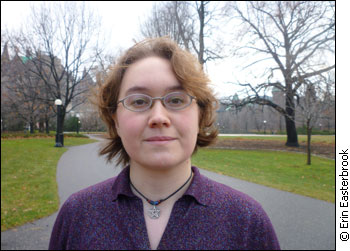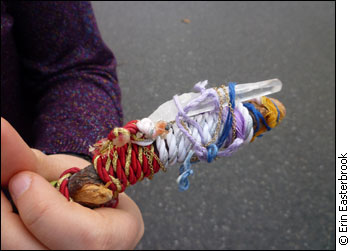Tags
Related Posts
Share This
Wicca’s widening spell
At Mavericks Bar on Rideau Street, it’s dark and people are masked. Intricately detailed, glittering masks hide many female faces. Some men wear Merlin-like hats. Decked in cloaks, robes and other attire reminiscent of centuries past, people form a circle.
Centered stands an altar, with an athame (a double-edged dagger) symbolizing the element air, and a cup of water representing the element water. Quiet drumming sets the mood and individuals of all ages hold hands with their neighbours. A suited man wearing a top hat beats his cane in harmony with the drumming. Skeletons made of pâpier-maché and chicken wire hang, swaying above the bar’s stage, reflecting the room’s energy.
This is Samhain, one of the biggest Wiccan holidays.
Samhain is based on the ancient Celtic tradition of honouring the dead on Oct. 31, the marking of winter, when the veil between our world and the spiritual was believed thin. During this time, the Celts—who occupied Britain and other parts of northern Europe in the centuries before the Middle Ages, and whose descendants still inhabit Ireland, Wales, Brittany, and parts of Scotland—would dress up and feast. Scary costumes were believed to frighten the bad spirits. This is where our holiday Halloween comes from.
While Wicca’s origins date back to Europe’s prehistory, Wicca as a modern pursuit was popularized by Englishman Gerald Gardner in the 1940s and 50s. It is based on an ancient Celtic framework, borrowing many Celtic traditions—for instance, nature worship and the use of lunar cycles to chart time. “Wicca” is an Old English word, which connects etymologically to our “witch” and “wicked.” Some practitioners of Wicca call themselves Wiccans, but others may call themselves witches.
According to a 2007 New York Times article, Wicca is the fastest growing religion in the United States, based on a survey by the City University of New York that discovered 130,000 Wiccans in the United States in 2001 as compared to 8,000 in 1990.
By now there may be more, especially as such surveys may under-report: Not all individuals are open about religious affiliations.
Professor Shelley Rabinovitch, a Wiccan, teaches courses in religion, women studies and anthropology at Carleton University and the University of Ottawa. She says it’s important to note that Wicca is the fastest growing religion outside of immigration in North America. She says Wicca is growing largely because it’s empowering for women and because of its “autonomous” nature—meaning that Wicca employs no scripture, clergy or institutional body.
‘The idea of Wicca is that every person is their own priest.’
– Bart Cormier
The majority of Wiccans believe in at least one God and one Goddess. Individuals can relate to this divine feminine, which many other religions don’t worship, Rabinovitch says, adding that some individuals find it hard to connect with one-male-God-based religion such as Christian denominations offer.
Says 33-year-old Mary Pletsch, an Ottawa Wiccan, “Too much university English has taught me that if you’re constantly using the pronoun ‘He, He, He,’ you get a subconscious bias towards the male.”

Mary Pletsch with the Wiccan pentacle: a five-point star, with magical associations, also known as a pentagram.
Wicca’s autonomous nature helps worshippers understand and connect with divine figures more personally, Pletsch says.
“The idea of Wicca is that every person is their own priest,” says 34-year-old Bart Cormier, a Wiccan of Kanata. He adds that it’s healthy to take charge of personal spiritual growth.
Autonomous as Wicca is, its moral code—“An [If] it harm none, do what ye will”—is what unites all Wiccans. Basically, Wiccans may do as they want as long as their actions don’t hurt anyone or anything.
People are asked to fill the chairs that form a circle. “All the cool kids are doing it,” shouts Bart. The crowd laughs. The hooded high priest, who’s leading the ceremony, “draws the circle” by walking its perimeter with the athame to create protective, sacred ground. With a broom, a blonde woman sweeps the perimeter of the circle to symbolically remove unwanted negative energy. The high priestess, another leader of the ceremony, calls the “quarters”—spirits of the East, West, South and North. The drumming intensifies.
Wicca is a form of paganism (an umbrella term for non-mainstream, polytheistic religions). Like Christianity, for example, Wicca has many denominations: Gardnerian, Alexandrian, Georgian, Odyssean and more. They undoubtedly share similar values but may have different rituals, says Rabinovitch.
There are also many Wiccans, such as Pletsch, who may not necessarily belong to or identify with a denomination and who choose to customize.
Raised as a Lutheran, Pletsch says she felt little connection to God growing up. But looking back on her childhood, she says she had instinctive knowledge that the jackal meant something to her. She would carve the jackals out of ivory soap bars and keep them in her room.
This made sense when she researched the ancient Egyptian god Anubis, the masculine jackal-headed gatekeeper between life and death, and began to connect with and worship him. She also began to worship the ancient Egyptian feline goddess Bast, a figure that for her symbolizes protection.

Mary Pletsch’s wand: a stick of wood, decked with symbolic colours and items, used in magical workings.
Reached for comment, several Ottawa mainstream religious leaders differed in their views of Wicca. Father Alexander Pihach of Ottawa’s Annunciation Orthodox Cathedral says that customizing one’s religion doesn’t work in the long run.
He says it leads to new denominations; disagreements happen and people leave to start another. That’s why there are between 30,000 and 40,000 denominations of Christianity, he says, and the downfall is the loss of needed unity.
Wicca may be popular now, but Pihach says religions come and go. “It will function for a long time,” he predicts. “But then it will fade out.”
Pastor James Drennan of Ottawa’s Alta Vista Baptist Church describes religions that cherry-pick religious elements or religions that amalgamate others as “syncretistic”.
“I don’t believe [syncretism] is valid,” says Pastor James Drennan, of Alta Vista Baptist Church in Ottawa. He says people can follow whatever path they want, but it comes down to truth—an objective standard.
“Categorically, [Wicca is] what they call a false theological system. Wicca does not represent truth,” he says. He clarifies that any syncretistic religion is not valid.

Wicca’s perception problem. In an unknown painter’s rendering of the famous 1790 Robert Burns poem “Tam o’ Shanter,” the terrified Tam barely escapes a coven of malicious witches.
But Rev. Dr. Dana Fisher of the Anglican Church of St. John the Evangelist in Ottawa says that all religions borrow things from other religions.
For instance, she says the story of Noah and the flood found in the Hebrew Scripture, and respected by Christians, was a story from the Babylonian Empire long before the Jews had it. “Each group cuts and pastes stuff whether it be doctrinal or ritual,” says Fisher. Therefore, Wicca is hardly the only syncretistic religion, she says.
Although Pastor Drennan criticizes the cherry-picking of religious elements, Rabinovitch says this is neither good nor bad.
“But it means it’s a challenge when you start talking about things like pagan community. The concept of community is what unites religions around the world,” she says.
She says witchcraft is misunderstood, as there are positive and negative connotations associated.
The girl to my right, new to Wicca, dips her popsicle stick into the bowl of steeped mugwort—an herb associated with the unconscious, said to increase psychic abilities—that’s being passed around, and tastes it. “What does it taste like?” I ask. “Bitter,” she says. The girl to my left laughs at us. “It’s a plant,” she says. A bowl of honey is then passed around to return to consciousness.
Cormier says because of the negative connotations, Wiccans are often portrayed as Buffy-the-Vampire-Slayer-style lunatics.
Rabinovitch disputes the emphasis on syncretism or cherry-picking in certain criticisms of Wicca. What’s important is the difference between good and bad people, she says, not the fact that someone is a witch.
For example, she says that just because former colonel Russell Williams is a bad person doesn’t mean that everyone in the military is bad.
They repeat a song that finishes with “They will know that we are pagans by our love, by our love; yes they know that we are pagans by our love.” By now, the skeletons are really swaying.
Some First Nation natives have accused neo-pagans of taking their spiritual components in a colonialist manner, says Cormier. That’s why Wiccans need to do their research, he says, to respect the traditions the elements come from.
“I think Wicca in its current form is an attempt to reconstruct a face that has since ceased to be practised,” Cormier says. “There’s always an attempt to look backwards to things that we find resonate with us today.”
The ceremony ends, and it’s time to dance. Everyone is invited to sign the Book of the Dead, used to commemorate deceased relatives. A red pentacle flashes on the brick wall as the congregants get their groove on to Michael Jackson’s Thriller.





